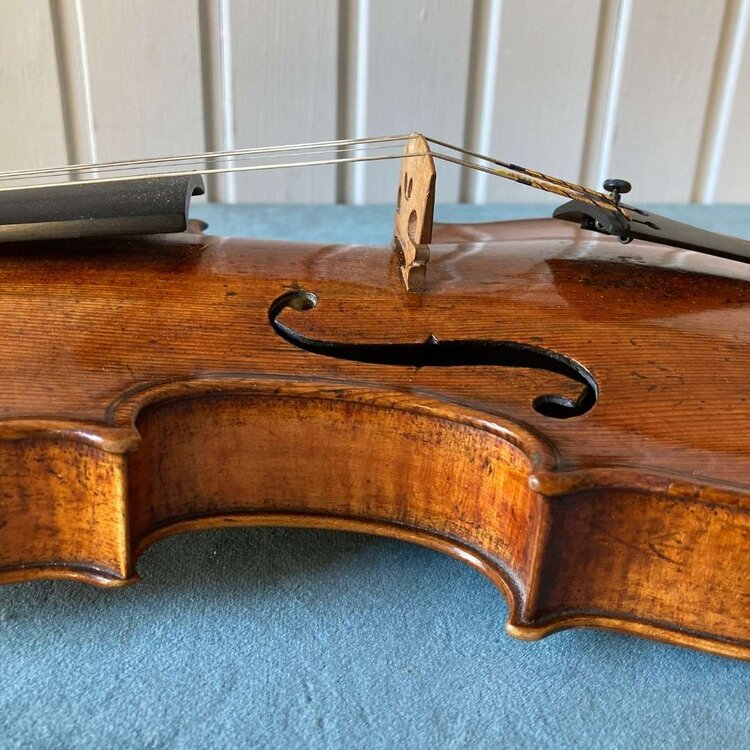For many aficionados of violins, the instruments of the early London maker Daniel Parker are like the holy grail: rare, precious and mysterious. To understand why, one must delve into who Parker was, where he lived, and those with whom he worked.
Who was Daniel Parker?
Unfortunately, the answer to the first of these questions is not known. There are dozens of Daniel Parkers in the birth and death records of Southwark Cathedral in the second half of the 17th century, with little clue as to which one is our man. What we do know about him is that we can see his hand in the instruments of several of his contemporaries.
One of the earliest Parkers I have seen was almost certainly made for the London luthier Barak Norman to sell as one of his own. The model was pure Norman, and it had the classic Barak Norman sound holes; almost symmetrical across the nicks, top to bottom. However, the scroll and varnish betrayed the true maker, and the violin was confirmed by Charles Beare as a Parker made in 1705. Another instrument which definitely shows Parker’s hand and/ or influence is the violin labelled John Hare which is pictured on pages 200 and 201 of The British Violin.
So we are building up an image of the man - someone who likely lived relatively hand to mouth. Someone who never graduated to having his own premises and business, but rather mainly spent his time making and part making instruments for his more commercially successful contemporaries. So why the big deal? There are hundreds of such makers, lost to history: what makes Daniel Parker so special?
The answer is the sheer quality of Parker’s work. The way that violin experts rank different makers differs from individual to individual, but for all of us, essentially it boils down to a few simple criteria. We tend to rate instruments in terms of their model, workmanship, varnish and sound: Daniel Parker does exceptionally well in all of these categories.
Model
History has awarded Parker the title of being one of the first makers outside of Italy to copy the instruments of Stradivari, during the latter's lifetime. We start seeing a shift in Parker’s instruments soon after the Cremonese violinist Gaspar Visconti came to town in 1703 playing on a long pattern Stradivari. Clearly this concert tour made a big impression on Parker and his contemporaries!
We see echoes of Parker and his championing of Stradivari’s Long Pattern throughout British violin making from then on, from Collingwood and Sexton, two London makers who likely knew Parker, to the Furber family, to Charles Harris the Oxford violin maker, and all the way up to Edinburgh and the so called ‘Scottish Stradivari’, Matthew Hardie.
Workmanship
In terms of workmanship, we are all used to seeing clean and boring Strad copies. Parker very much imbues the model with his own character and quirks. His work is quick and not always as full of care as his great muse, but always extremely skilful. Like Stradivari, he experimented a great deal, with some instruments being made rather small, and others much larger. This curious mindset comes through in almost everything we see of him.
Varnish
Parker’s varnish, which is of fantastic quality, sometimes golden, sometimes a rich red, is always transparent and luminous. His golden varnishes often chip in a very similar way to the varnish of Lorenzo Storioni, and the bold reds wouldn’t look out of place on a Milan period Guadagnini. This quality of varnish, in conjunction with the woodwork underneath and the age of the instrument, is what combines into an incredibly exciting end result. Parker’s instruments have frequently been mistaken for old Italian instruments. In recent times I have seen two of his instruments which have tricked respected experts, one being mistaken for a Mantuan maker and the other a fine Cremonese maker.
Sound
And finally, of course, we must talk about tone, because what good is a pretty violin if it doesn’t sound brilliant? Probably the most famous player to regularly use a Parker is Fritz Kreisler. He bought an example dated 1715 from W E Hill and Sons and then delighted in tricking people by playing it in concerts and passing it off as a Balestrieri and even a Strad. Quite the accolade!
Update: currently available
We are delighted to say that we currently have an exceptional cello by Daniel Parker for sale! You can see the cello here.
